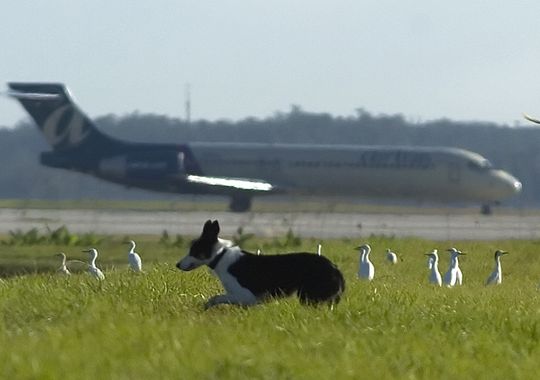Airports
Managing Wildlife for Airport Operators
Managing wildlife FOD is particularly important to airfield wildlife control operators since the greatest number of wildlife collisions occur within the vicinity of the airport.
The courts have also determined that the airport operator is responsible for operating a safe, wildlife-free facility and have a duty to warn flight crews of wildlife activity.
Managing Wildlife Attractants
Suggested Resources
Check out our articles on How To Prevent FOD at Your Airport or How to Set Up a FOD Program for more great ideas.
Airport wildlife management is normally conducted on two fronts, passive and active. Most birds and mammals are attracted to the airport environment because it has something they want; generally food, water or shelter. It can be argued that the most cost-effective wildlife management plan in airports is to eliminate or modify the attractions to ensure that wildlife avoids the airport.
Some wildlife control officers state that wildlife should be treated like unwanted relatives at your home — never let them get comfortable! Passive wildlife management is often referred to as habitat management. Unfortunately, it can never be completely successful because of the highly adaptive nature of most wildlife species.
If an airfield wildlife control operator dedicates approximately 80% of wildlife control resources to developing strategies for effective passive management, then only 20% should have to be dedicated to active wildlife control tactics. Active wildlife control includes tactics to disperse wildlife that has ignored the habitat management barrier.
Risk Assessment for Managing Wildlife
Prior to developing and implementing a wildlife management plan at an airport, it is essential that a risk assessment be conducted. If a data collection system is not already in place, begin by surveying wildlife numbers, species, locations and the times when they are observed. Create baseline data for assessing the effectiveness of changes in the program.

It is also important to continue collecting and analyzing wildlife strike data and to identify the species of wildlife struck by aircraft. All of this information is essential in order to make value-added changes to a program and to know when and where to dedicate resources. Commercial software is available that facilitates the documentation of control programs and provides the tools required to prepare risk assessments and wildlife management plans.
Prepping risk assessment sounds like a daunting task. But it is nothing more than keeping track and analyzing past and current circumstances at an airport with respect to aircraft operations, wildlife strike rates, and wildlife species and numbers. A large airport with a high volume of operations involving large turbine-powered passenger aircraft is immediately deserving of a formal wildlife control program.
On the other hand, a small airport that deals mostly with light piston-powered fixed wing aircraft may manage with a communications and warning procedure to advise pilots of unusual wildlife activity.
Airports considered to be high risk with respect to wildlife are usually those that have experienced high numbers of wildlife strike incidents, especially if those incidents have caused aircraft damage. Also in the high risk category are airports that have incompatible facilities such as landfills nearby, being near migrating waterfowl staging areas or other features that attract large flocking birds. These airports must implement aggressive wildlife control programs.
Airport Wildlife Management Plan
Once an airfield wildlife control operator has completed a risk assessment, the conclusions and data derived from the analysis can be used to prepare an airport wildlife management plan. A well developed management plan provides guidance for the allocation of wildlife control resources and includes information on issues such as:
- Staffing Levels and Vehicle Allocation
- Techniques and Products
- To be used for the various wildlife species that must be controlled
- Schedules for Wildlife Control Initiatives
- For example, many airports have serious wildlife problems at night making it necessary to schedule wildlife control activities around the clock. In some cases, migrating waterfowl create extreme demands on resources during the spring and fall
- Priority Lists
- It is essential that adequate control resources be dedicated to those wildlife species posing the greatest risk to aircraft. The risk assessment should provide this information. A priority list also enables the wildlife control team to focus their attention on species such as Canada Geese rather than on smaller birds that may not pose a significant threat
- Reporting Protocols
- It is important to record all wildlife sightings and all actions taken to disperse wildlife in order to gauge the success of products or techniques
- Communication Protocols
- For example, it is important that wildlife control officers have established procedures with ATS providers in case a flight operation has to be held back due to unusual wildlife activity
- Organization Charts
- Wildlife control officers must know who to report problems to. It is also essential that a committee is in place to provide a forum for wildlife control staff to address issues that require decision making by the airport wildlife management team.
- Endangered and Otherwise Protected Species
- Wildlife control officers must be aware and respectful of protected species legislation to avoid conflict with local enforcement agencies and animal welfare groups
- Permits for Lethal Control or Hazing
- Every airport must have appropriate permits for killing and hazing wildlife
- Firearms Permits
- Valid permits for the use and storage of all firearms are mandatory, and wildlife control staff must be trained in the safe use of firearms
- Habitat Management Plan
- An airport wildlife management plan should document the actions required to minimize the wildlife attractions at the airport
- Dispersal Plan
- Airport wildlife management plans should include information about the products used in hazing initiatives, the suppliers of products, human health and safety implications, and an inventory process to prevent stock depletion
Although not all encompassing, the preceding bullets summarize issues that must be addressed in an airport wildlife management plan. The effectiveness of an airport wildlife control program is dependent on a science-based formal risk assessment and management planning process. The cost associated with developing the risk assessment and management plan will be recovered as efficiency gains are realized.
Perhaps even more important is the value provided by a formal, documented plan should legal action be taken by an air carrier following a damaging wildlife strike incident. It is also useful and cost-effective to include a professional biologist who has experience with wildlife hazard management plans.
Issues associated with natural science applications can be much more complex than first assumed, and current knowledge of effective wildlife management strategies and tactics is crucial to a successful plan. Finally, an airport wildlife management plan must be signed-off by the management team, demonstrating support and commitment for the program.
Passive Management
Passive management refers to the habitat management initiatives that an airfield wildlife control operator can take to reduce the attractiveness and accessibility of the airport to wildlife. The primary goal is to eliminate or modify food, water and shelter resources. It is important to eliminate, modify or manage all food sources that may attract wildlife, such as human food waste, fruit-producing vegetation, seed crops, agricultural activities and certain types of prey.
All open and running water must be managed to either make it unavailable or unattractive to wildlife. Finally, shelter habitat, such as old hangars or forested areas on the airfield, should be modified or removed in order to deny use by wildlife as a place to rest or hide. Signs, airport lighting fixtures and buildings should all be designed or modified to prevent birds from using them as perching or nesting habitat. A well-maintained, properly designed fencing system will prevent deer from accessing aircraft movement areas.
Active Control
Active wildlife control usually refers to the dispersal or hazing initiatives undertaken by wildlife control teams. There are many products advertised for dispersing wildlife. But it is important that airfield wildlife control operators carefully study a product before investing large sums of money, and obtain advice of recognized experts in the wildlife management profession. Many products are designed for the agricultural industry where their effectiveness is only required for a relatively short period of time as crops ripen.
However, in an airport environment, products and techniques must be effective for a much longer period of time. Also, the efficacy of many products has never been tested in a rigorous, independent environment and is only supported by advertising claims and anecdotal evidence. Wildlife eventually adjusts to almost any tactic used to disperse it. If a technique or product does not cause physical harm, wildlife will eventually begin to ignore the threat.
Despite advances in the science of wildlife management, the time-proven technique of hazing with noise producing pyrotechnic products is still considered to be the most effective way to disperse wildlife. Pyrotechnic programs must be properly conducted to remain effective over the long term, but skillful application of pyrotechnics is likely the most effective means of dispersing wildlife.
Devices that may pose a fire threat must be handled only by properly trained personnel, and may be prohibited in some areas or during times of fire danger. High-risk areas should consider other tactics except under ideal fire-safe conditions.
Falconry can be an elegant way to disperse birds, and it has the added advantage of being acceptable to most animal welfare groups. At the end of the day, falconry is expensive, very dependent on motivated and experienced handlers, and only useful during periods of good weather.
However, it does provide a public relations benefit to a large airport operation that can be of priceless value. If a falconry team uses other techniques to address the limitations, a falconry program can make it easier for airport management to deal with negative publicity that is associated with wildlife control programs.
This list of actions that can be taken by an airport operator to minimize the exposure and probability of wildlife collisions with aircraft is in no way complete. There are many excellent publications that provide more detailed information on wildlife management strategies and tactics. Probably the most important point that we can make is that an informal, ad hoc wildlife program may be doomed to failure.
Successful airport wildlife management requires formal, science-based underpinnings and long-term success depends on flexibility, motivation and persistence. A truly successful wildlife control team will always have the support and commitment of the airport management team. The team will continuously search for new and innovative ways to counter the threat that wildlife poses to safe airport and aircraft operations.

